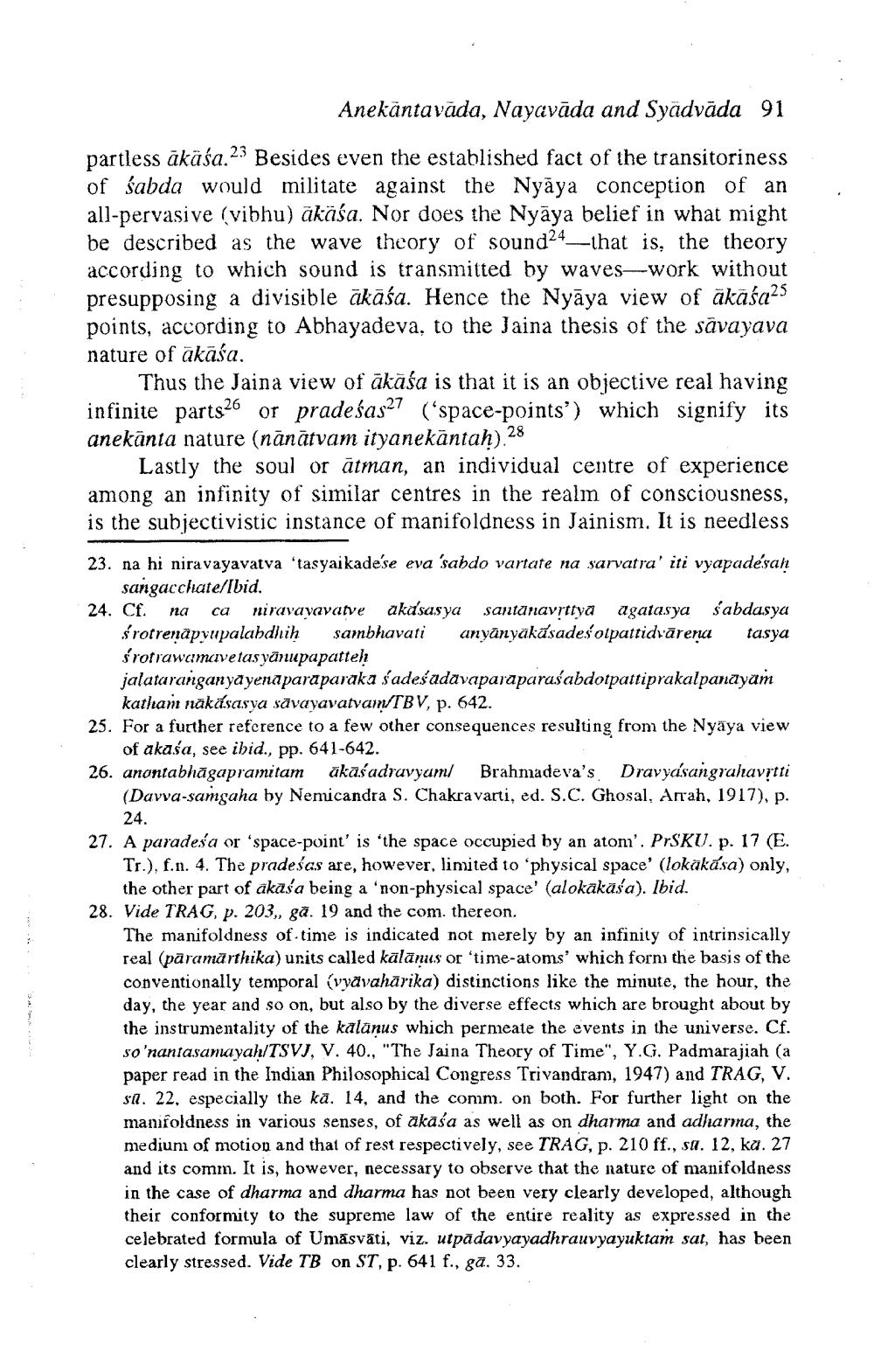________________
Anekantavada, Nayavāda and Syadvāda 91
partless ākāśa.23 Besides even the established fact of the transitoriness of śabda would militate against the Nyāya conception of an all-pervasive (vibhu) ākāśa. Nor does the Nyāya belief in what might be described as the wave theory of sound24—that is, the theory according to which sound is transmitted by waves-work without presupposing a divisible ākāśa. Hence the Nyāya view of äkāśa25 points, according to Abhayadeva, to the Jaina thesis of the sāvayava nature of ākāśa.
Thus the Jaina view of ākāśa is that it is an objective real having infinite parts26 or pradeśas27 ('space-points') which signify its anekānta nature (nānātvam ityanekantah).28
Lastly the soul or ātman, an individual centre of experience among an infinity of similar centres in the realm of consciousness, is the subjectivistic instance of manifoldness in Jainism. It is needless
23. na hi niravayavatva 'tasyai kade'se eva 'sabdo vartate na sarvatra' iti vyapadesah
sangacchate/Ibid. 24. Cf. na ca niravavavatve aka sasya santanavrttya agatasya sabdasya
ś rotrenäpvupalahdhih sambhavati anyanyākāsades oipattidvārena tasya s rotrawamavetas yānupapatteh jalataranganyayenaparaparaka sadeśadavaparaparaśabdotpattiprakalpanayam
katham nākāsasya sāvayavatvam/TBV, p. 642. 25. For a further reference to a few other consequences resulting from the Nyaya view
of akaśa, see ihid., pp. 641-642. 26. anontabhāgapramitam akaś adravyuml Brahmadeva's Dravyasangrahavịtti
(Davva-samgaha by Nemicandra S. Chakravarti, ed. S.C. Ghosal, Anah, 1917), p.
24. 27. A paradesa or 'space-point' is 'the space occupied by an atom'. PrSKU. p. 17 (E.
Tr.), f.n. 4. The pradesas are, however, limited to 'physical space' (lokakása) only,
the other part of akaśa being a 'non-physical space' (alokakasa). Ibid. 28. Vide TRAG, p. 203,, gā. 19 and the com. thereon.
The manifoldness of time is indicated not merely by an infinity of intrinsically real (pāramarthika) units called kälānus or 'time-atoms' which form the basis of the conventionally temporal (vyavahārika) distinctions like the minute, the hour, the day, the year and so on, but also by the diverse effects which are brought about by the instrumentality of the kalānus which permeate the events in the universe. Cf. so'nantasamayah/TSVJ, V. 40., "The Jaina Theory of Time", Y.G. Padmarajiah (a paper read in the Indian Philosophical Congress Trivandram, 1947) and TRAG, V. sa. 22, especially the ka. 14, and the comm. on both. For further light on the manifoldness in various senses, of akaśa as well as on dharma and adharma, the medium of motion and that of rest respectively, see TRAG, p. 210 ff., sa. 12, ka. 27 and its comm. It is, however, necessary to observe that the nature of manifoldness in the case of dharma and dharma has not been very clearly developed, although their conformity to the supreme law of the entire reality as expressed in the celebrated formula of Umāsvāti, viz. utpādavyayadhrauvyayuktam sat, has been clearly stressed. Vide TB on ST, p. 641 f., ga. 33.




